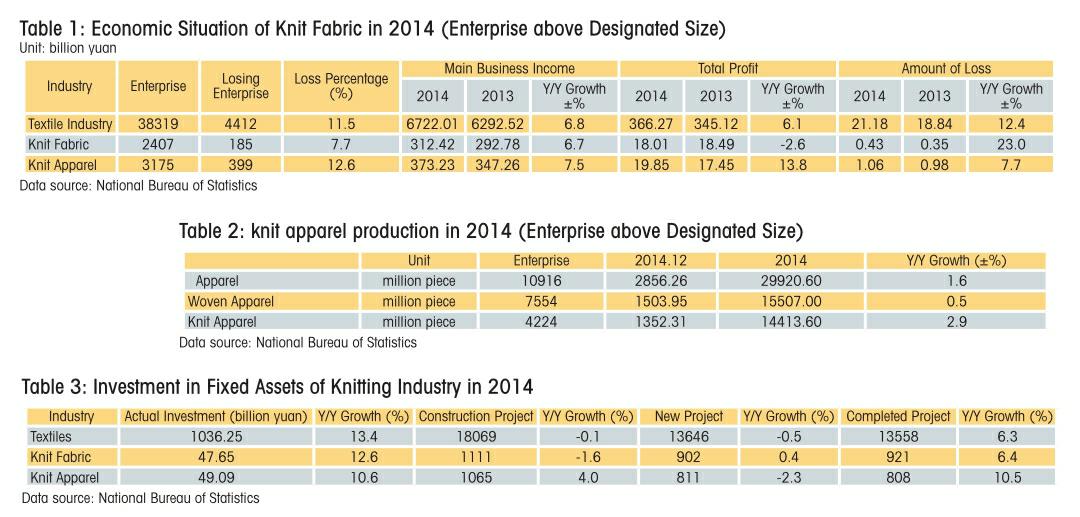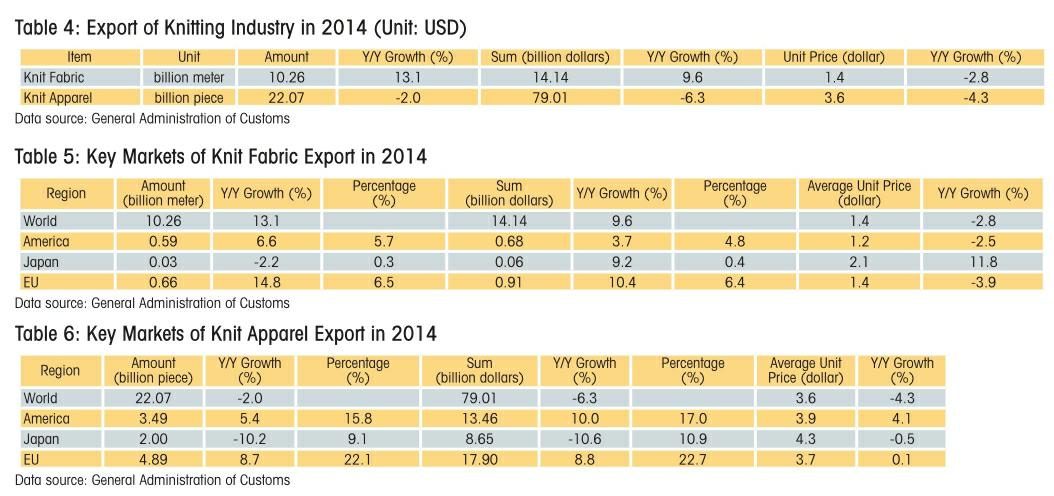Knitting:Exports over one hundred billion dollars
Against the slow recovery of world economy, China knitting industry reached annual export volume of $ 106.14 billion, which were better than expected, although it decreased compared with previous year, accounting for 34.5% of textile and apparel export ($ 306.96 billion), down by three percentage points.
Knit apparel corporations had good profi t
According to National Bureau of Statistics, knit fabric enterprises above designated size reached main business income of 312.42 billion yuan in 2014, with a year-on-year increase of 6.7%, total profi t of 18.01 billion yuan, down by 2.6% over the same period of previous year, with year-on-year growth of 23.0% in loss amount. While knit apparel companies gained 373.23 billion yuan on main business income, with a year-onyear increase of 7.5%, total profi t of 19.85 billion yuan, rising by 13.8% over the same period of previous year, with year-on-year growth of 7.7% in loss amount. Thereinto, the profi ts of knit apparel grew better than textile industry and apparel industry, suggesting good profi t of knit apparel against the poor situation of the whole industry. (Detailed information refers to Table 1)
Knit apparel production maintained slight positive growth
In 2014, knit apparel kept positive growth, with growth rate of 2.9% and cumulative production of 14.41 billion. The production increase of four quarters were 5.3, 5.8, 3.9 and 2.9 respectively, showing a downward trend, but better than the negative growth of whole year in 2013. (Detailed information refers to Table 2)
In terms of cumulative production, the top fi ve were still the traditional five provinces of Guangdong, Fujian, Zhejiang, Shandong and Jiangsu, among which Guangdong Province enjoyed signifi cant increase in production by double digits, while Shanghai has declined, only ranking the ninth position, down by 8.98 % over the same period of previous year.
Domestic investment became more rational
From the perspective of investment, the two sectors of knitting industry reached year-on-year investment increase of 12.6% and 10.6% respectively, lower than the average growth of the industry, especially the knit apparel. Compared with sharp rise of 42% in 2013, domestic investment of knitting industry became more rational in 2014. (Detailed information refers to Table 3)
Annual export continued over one hundred billion dollars
According to General Administration of Customs, the cumulative amount of knit fabric exports amounted to 10.26 billion meters and cumulative sum was $ 14.14 billion, with year-on-year increase of 13.1% in quantity and 9.6% in sum, as well as decline of 2.8% in unit price; knit apparel exports amounted to 22.07 billion pieces and $ 79.01 billion, with amount falling by 2.0%, value decreasing by 6.3% and unit price declining by 4.3%. (Specifi c data was shown in Table 4)
The analyses showed that export prices were mainly impacted by the raw material. For example, the amount of cotton knit apparel decreased sharply, which was connected with high prices of domestic cotton, simple styles of cotton knit apparel and easy transfer to the emerging countries like Bangladesh and India, etc.
Analysis of key export markets for knit fabric showed that the United States and the EU market has experienced increase in amount of 6.6% and 14.8% respectively, but the price fell slightly. Meanwhile the amount to Japan declined slightly, while the unit price presented double-digit growth, as shown in Table 5.
In terms of key export market of knit apparel, the United States and the EU market were also showing year-on-year increase of 5.4% and 8.7% respectively, yet with slight increase in unit price, however, it experienced slight decline in both export amount and unit price in Japan market, as shown in Table 6.
Knit apparel imports increased dramatically
In 2014, Chinas dependence on imports of knit fabric has improved, which showed by decrease of amount and increase of unit price, indicating that only high-end fabrics need to rely on imports. The imports of knit apparel grew, especially from Vietnam, Bangladesh, Turkey, Cambodia and Thailand, which may be related to industrial transfer and international investments, as well as the outerwear trend of knit apparel.

